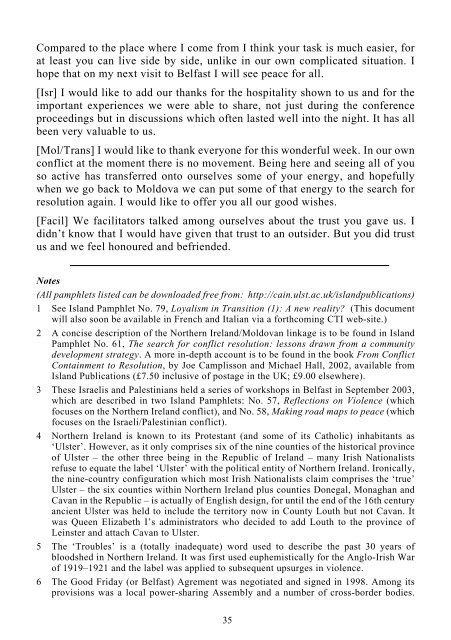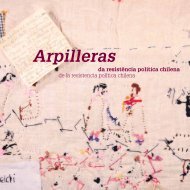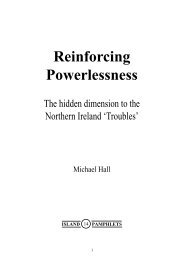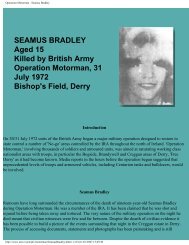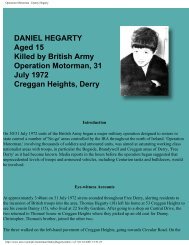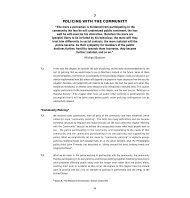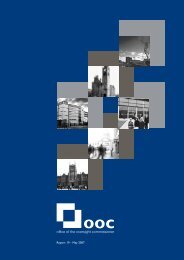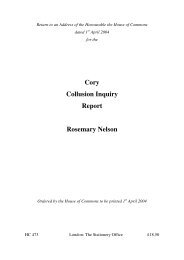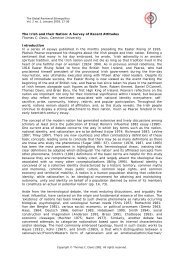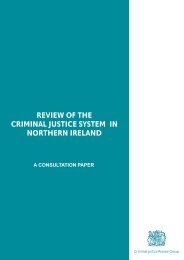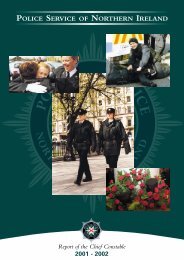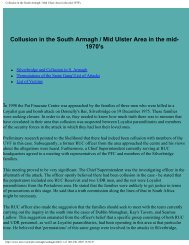Learning from others in conflict - CAIN
Learning from others in conflict - CAIN
Learning from others in conflict - CAIN
- No tags were found...
Create successful ePaper yourself
Turn your PDF publications into a flip-book with our unique Google optimized e-Paper software.
Compared to the place where I come <strong>from</strong> I th<strong>in</strong>k your task is much easier, forat least you can live side by side, unlike <strong>in</strong> our own complicated situation. Ihope that on my next visit to Belfast I will see peace for all.[Isr] I would like to add our thanks for the hospitality shown to us and for theimportant experiences we were able to share, not just dur<strong>in</strong>g the conferenceproceed<strong>in</strong>gs but <strong>in</strong> discussions which often lasted well <strong>in</strong>to the night. It has allbeen very valuable to us.[Mol/Trans] I would like to thank everyone for this wonderful week. In our own<strong>conflict</strong> at the moment there is no movement. Be<strong>in</strong>g here and see<strong>in</strong>g all of youso active has transferred onto ourselves some of your energy, and hopefullywhen we go back to Moldova we can put some of that energy to the search forresolution aga<strong>in</strong>. I would like to offer you all our good wishes.[Facil] We facilitators talked among ourselves about the trust you gave us. Ididn’t know that I would have given that trust to an outsider. But you did trustus and we feel honoured and befriended.Notes(All pamphlets listed can be downloaded free <strong>from</strong>: http://ca<strong>in</strong>.ulst.ac.uk/islandpublications)1 See Island Pamphlet No. 79, Loyalism <strong>in</strong> Transition (1): A new reality? (This documentwill also soon be available <strong>in</strong> French and Italian via a forthcom<strong>in</strong>g CTI web-site.)2 A concise description of the Northern Ireland/Moldovan l<strong>in</strong>kage is to be found <strong>in</strong> IslandPamphlet No. 61, The search for <strong>conflict</strong> resolution: lessons drawn <strong>from</strong> a communitydevelopment strategy. A more <strong>in</strong>-depth account is to be found <strong>in</strong> the book From ConflictConta<strong>in</strong>ment to Resolution, by Joe Camplisson and Michael Hall, 2002, available <strong>from</strong>Island Publications (£7.50 <strong>in</strong>clusive of postage <strong>in</strong> the UK; £9.00 elsewhere).3 These Israelis and Palest<strong>in</strong>ians held a series of workshops <strong>in</strong> Belfast <strong>in</strong> September 2003,which are described <strong>in</strong> two Island Pamphlets: No. 57, Reflections on Violence (whichfocuses on the Northern Ireland <strong>conflict</strong>), and No. 58, Mak<strong>in</strong>g road maps to peace (whichfocuses on the Israeli/Palest<strong>in</strong>ian <strong>conflict</strong>).4 Northern Ireland is known to its Protestant (and some of its Catholic) <strong>in</strong>habitants as‘Ulster’. However, as it only comprises six of the n<strong>in</strong>e counties of the historical prov<strong>in</strong>ceof Ulster – the other three be<strong>in</strong>g <strong>in</strong> the Republic of Ireland – many Irish Nationalistsrefuse to equate the label ‘Ulster’ with the political entity of Northern Ireland. Ironically,the n<strong>in</strong>e-country configuration which most Irish Nationalists claim comprises the ‘true’Ulster – the six counties with<strong>in</strong> Northern Ireland plus counties Donegal, Monaghan andCavan <strong>in</strong> the Republic – is actually of English design, for until the end of the 16th centuryancient Ulster was held to <strong>in</strong>clude the territory now <strong>in</strong> County Louth but not Cavan. Itwas Queen Elizabeth I’s adm<strong>in</strong>istrators who decided to add Louth to the prov<strong>in</strong>ce ofLe<strong>in</strong>ster and attach Cavan to Ulster.5 The ‘Troubles’ is a (totally <strong>in</strong>adequate) word used to describe the past 30 years ofbloodshed <strong>in</strong> Northern Ireland. It was first used euphemistically for the Anglo-Irish Warof 1919–1921 and the label was applied to subsequent upsurges <strong>in</strong> violence.6 The Good Friday (or Belfast) Agrement was negotiated and signed <strong>in</strong> 1998. Among itsprovisions was a local power-shar<strong>in</strong>g Assembly and a number of cross-border bodies.35


